|
Cape Town
Basic Orientation
With four distinctive mountains, orientation in Cape Town is very easy. Nearest to the ocean is the 35-meter high Signal Hill. A road leads up to its peak, with the parking area at the top a popular spot for watching the sun set over the Atlantic. It also offers exceptional views of the city center, the National Stadium and Table Bay with the V & A Waterfront entertainment and shopping complex. Originally the hill was named Lion’s Rump, because of its position relative to Lion’s Head, a conical 689-meter high hill. This is a paragliding center and the climb to a suitable starting point with heavy paragliding equipment in a backpack is a considerable sporting achievement. The city is dominated by Table Mountain, a large massif with an altitude of 1088 meters, and an unusually flat, broad top. The mountain faces the city with its steep, almost perpendicular rock cliff several hundred meters high. A tooth protrudes on the western side of the flat top which, on closer inspection, turned out to be the upper cableway station. The fourth mountain is the 1000-meter Devil’s Peak.

[Cape Town] Street in front of Zebra Crossing hostel

[Cape Town - Gardens] Evening view from the sidewalk in front of the Zebra Crossing hostel

[Cape Town - Waterfront] It is hard work building such a mountain and, as you can see, the construction must regularly be maintained
The first exploration of a city is always very materialistic. The most important requirement is getting to know where one can buy good food and booze. Both were literally around the corner. The two kilometers of the busy Long Street leading to the city center were lined with pubs, Backpackers, cheap as well as expensive restaurants, clothing stores and stores selling African hand-crafted products. That was sufficient for an afternoon, and at the same time I saw a considerable part of the city.
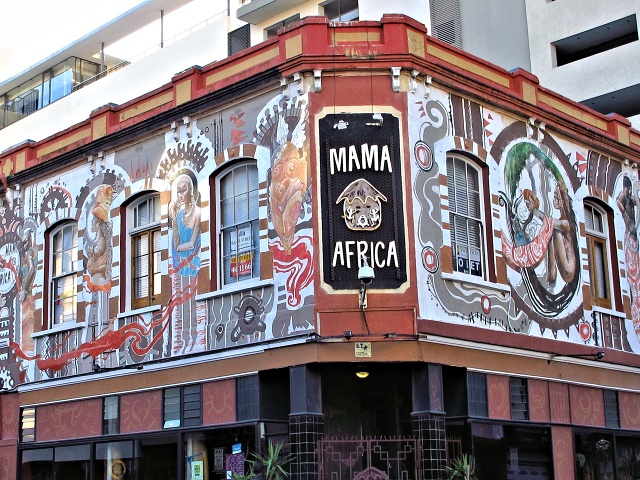
[Cape Town] Long Street is a varied mix of pubs, Backpackers, small hotels and associated services
The next day I devoted myself to my forthcoming departure. I found the nearest bike store on the Internet, requested a box for the bike, and was sold one for 50 Rands. This was the first time on my travels that I had not been given a box free of charge. I also bought packaging material for the rest of the equipment – box, tape, wrapping foil. I would reach the Airport via a shuttle, which would pick me up at the agreed time at the hostel. This was nice, I would not have to pack at the Airport. In addition, boxes for bikes reportedly are not sold there and cycling with the box in the local strong wind would have been risky. I had a hard time getting the box to the hostel seven blocks away, as I went on foot.
I dried out all my camping equipment – tent, sleeping bag, sleeping mat. I cleaned the gasoline cooker and poured off the remaining gasoline. I had my dirty clothes washed in the hostel. One load in the washing machine cost 25 Rands. They had no dryer, but the laundry had dried perfectly by the evening.
V & A Waterfront
In the afternoon, I went to see the V & A Waterfront. V stands for "Victoria" and A for "Alfred". Many people get this wrong and believe that A is for "Albert", husband of Queen Victoria. No, it is "Alfred", her son, who was the first member of the Royal family to visit South Africa in 1867. Streets in several towns are named after him, as well as a famous mountain pass. The Waterfront is located in Table Bay, in the heart of Cape Town's working harbor. Pedestrian access from the city is not very simple at first, mainly because of the busy four-lane road which must be crossed. The beginning looks unattractive, docks and repaired boats, noise, dust, dirt, dug-up sidewalks. When you get past this, you are in a tourist oasis. Arriving by car is much more pleasant.
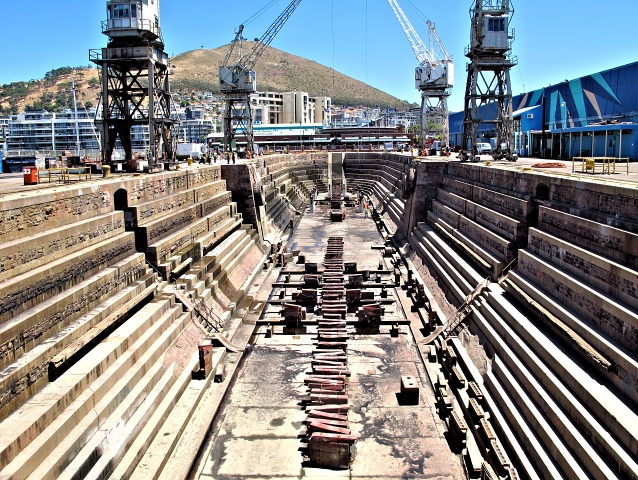
[Cape Town - Waterfront] The dry dock ready to accept another ship for repair
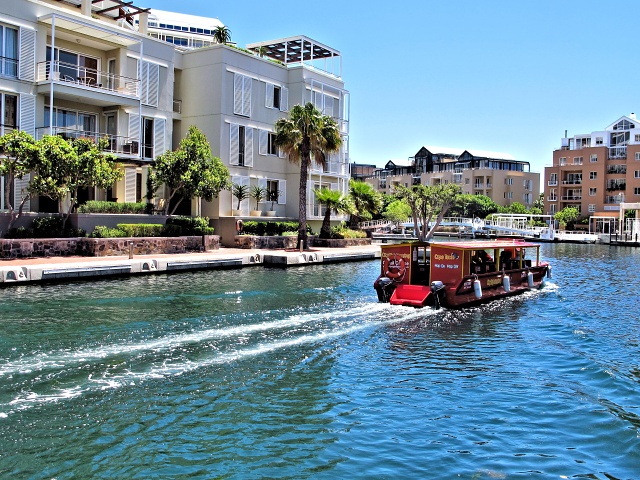
[Cape Town - Waterfront] Harbor pleasure cruise

[Cape Town - Waterfront] Something for the children
Regardless of the name, this is the most popular place to spend the daytime in Cape Town. Nightlife here is not so good. After all, it is more than a kilometer from the city center. Long Street is the best venue for boozing. Of course there is a large shopping mall, where one finds world-renowned brands and plenty of other expensive stores. It was my bad luck that there was not enough space for toy stores, as I always need to buy gifts for my four grandchildren. As they are acquiring reason, I cannot fool them with some standard Chinese plastic kitsch. There were only two toy stores, one a complete horror. In the second I found something to buy. However, for the two oldest boys, cousins, I have to buy identical items, including the color, and if not, there will be major problems. And unfortunately, of the items that I liked, there was always only one. It was clear to me that I would have to buy the toys elsewhere.
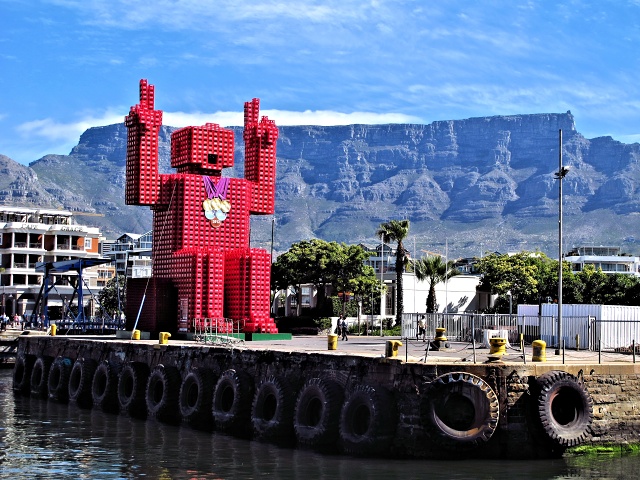
[Cape Town - Waterfront] Landmark statue made of Coca Cola crates, resembling a Lego construction
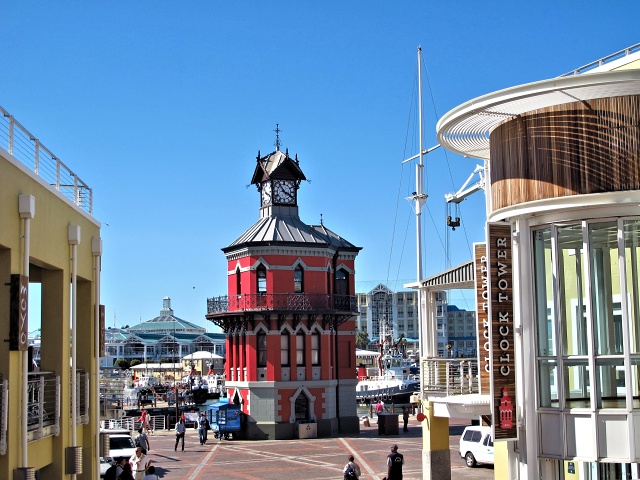
[Cape Town - Waterfront] Clock Tower
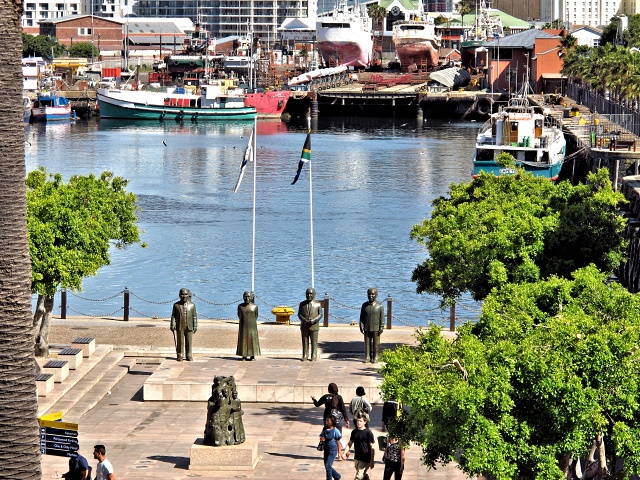
[Cape Town - Waterfront] Nobel Square with 4 South African Nobel Prize holders (Luthuli, Tutu, De Klerk, Mandela)
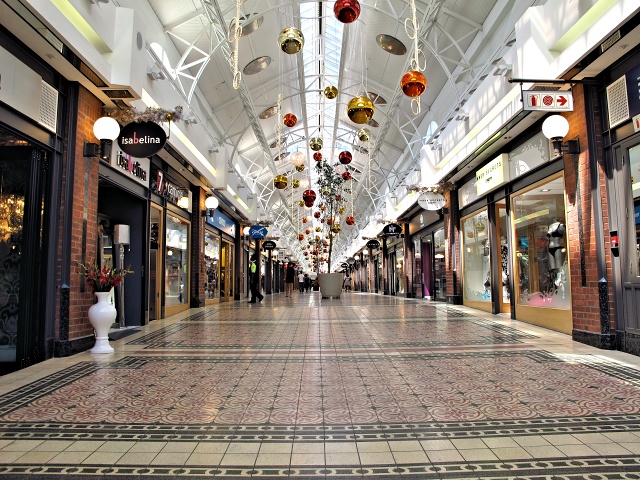
[Cape Town - Waterfront] Shopping mall at the Cape Town Waterfront
City Sightseeing Cape Town
This is the name of the company operating the tourist buses. The concept is great. They use red double-deckers, similar to the famous London buses. They have open tops, most of the people preferring to sit up there, frying themselves in the sun and facing the strong winds. There are two routes – the Red is through the city with a stop at the Table Mountain cableway station. The Blue leads around the peninsula, with the furthest point being Hout Bay. Routes on the Atlantic coast overlap from Camps Bay up to the Waterfront, but it does not matter at all. The coast is so beautiful and interesting that one finds something new there each time. The hop on–hop off system is great too. You can get off at any stop and then hop on another bus later.
The most advantageous is to buy a two-day ticket, which is valid for any route on two consecutive days. It costs 250 Rands (220 Rands when buying online, but they want a printed ticket to be able to scan the bar code) and also includes a canal ride in the harbor and an evening excursion to watch the sunset from Signal Hill, which otherwise can be purchased separately. The one-day or two-day tickets are connected with many discounts at museums, so it pays to throw away the ticket only after departure from Cape Town. Those who like things in order, can keep the ticket and, with it, apply for a 10% discount on the tourist buses operated by this company in other cities.
I found a Red bus stop about five minutes from the hostel. I bought the ticket on the bus, obtained headphones and off we went. The headphones transmitted a series of data on the area we were passing through, very informative and entertainingly seasoned with personal anecdotes, curiosities, life stories. It was prepared by pros and was really worthwhile. It was possible to choose from about 10 different languages, Czech of course was not on the menu. I had great fun with the “I photograph what I see” approach. Most people were taking photos from the moving bus, with all its shaking and the vistas obstructed by constructions or trees. I do not mind 60-year-old ladies doing this, but young people with full-frame reflex cameras should know that nothing will come out of such clicking. Well, they will live and learn…

[Cape Town] On board the tourist bus
To the Top of Table Mountain
I got off at the lower Table Mountain cableway station. It looked bad. The cableway was not operating due to the wind, yet people were already standing in 45-minute lines. I should explain that people wait in a designated area, with signs for every 15 minutes of the expected wait. So I had 45 minutes to the ticket office, but the cableway was not operating. The staff informed us that they would start operations in one hour at the earliest. Many people could not bear this mentally and left the line. So I gradually worked my way up to 15 minutes. I was determined to get up the mountain at all costs. If I'd had a car, I could have taken the road up to the spot from which the climb takes less than two hours. But these were idle considerations, so I simply waited. Finally, it was not so bad and after 90 minutes of waiting I was in the cable car.
The cableway has a 1,200-meter long cable (from the lower to the upper station), the capacity is 65 people in the cab, that is 800 per hour. The cables are tightened by counterweights, each weighing 134 tons. Due to the strong wind, each cabin has containers holding 4,000 liters of water, with a carrying capacity of 5,200 kg. The water weight, carried in case of necessity, is poured out at the upper station, thus replenishing the supply of drinking and service water. And what is really interesting, the cabin floor rotates during the ride. This is reportedly for the purpose of stabilization in a very strong wind. But the rotation was slow, on the way up, we rotated through about 270 degrees. Certainly it can be controlled. On the way down, the guys operating the cabin asked us if we wanted to turn the rotation off.
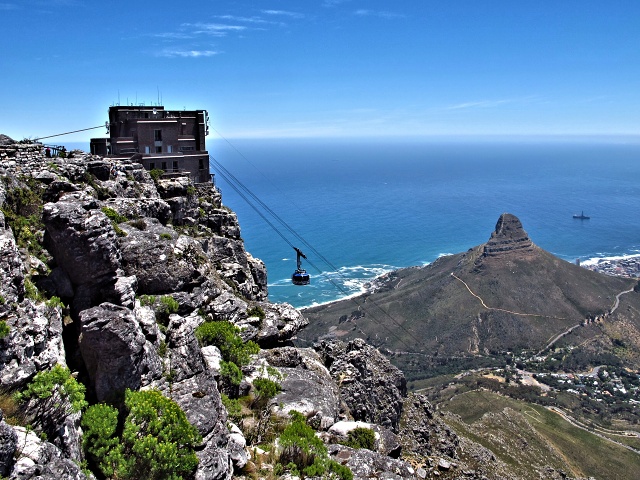
[Cape Town - Table Mountain] The upper cableway station, Lion’s Head in the background
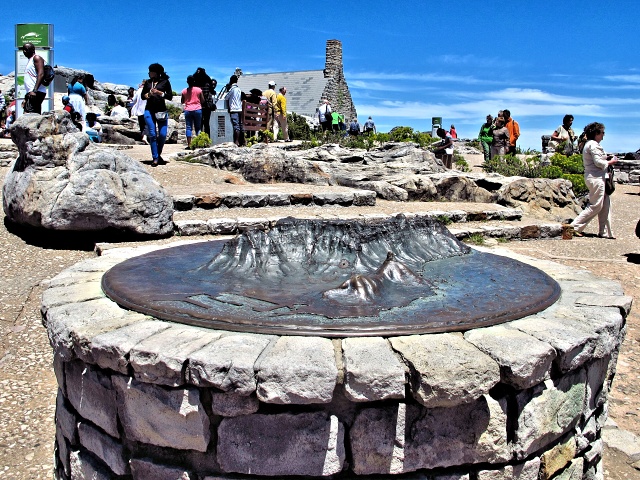
[Cape Town - Table Mountain] Model of all the surrounding hills—top of Table Mountain
The peak is a flat rocky plateau on which three walking trails are marked out – the 15-minute Dassie Walk, 30-minute Agama Walk and 45-minute Klipspringer Walk. Most people choose the shortest, because they do not have adequate clothing, and the wind blows strongly on the peak and it is cold up there. I was prepared and that is why I enjoyed the longest walk with pleasure. The views are wonderful, of the city, of the bay, of the other side towards Camps Bay and then views up to the Cape of Good Hope which, however, cannot be seen from the mountain top.
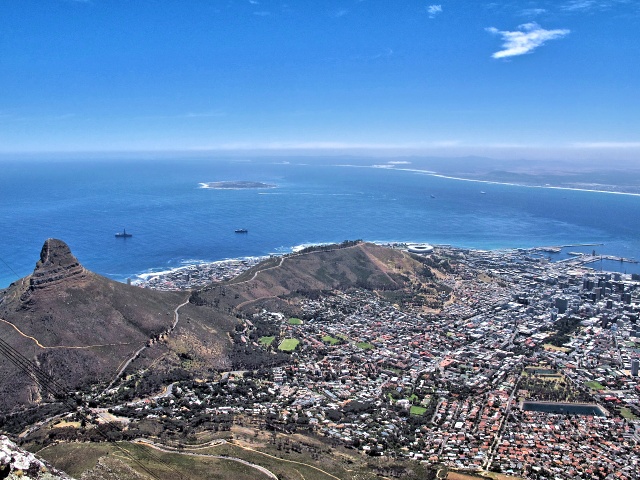
[Cape Town - Table Mountain] View of Lion’s Head, road to Signal Hill and Cape Town center

[Cape Town - Table Mountain] View of Camps Bay
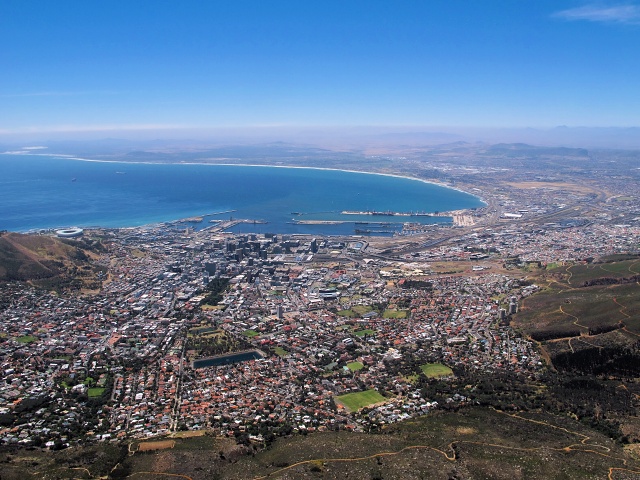
[Cape Town - Table Mountain] The Atlantic coast stretching to the town of Table View
Camps Bay and Other Beaches
I sailed down the mountain by cableway like a proper rich man. Due to my shoes, I’d rather have climbed up than walked down. I jumped on to a Red bus and was transported to the cosmopolitan center of Camps Bay. From the saddle between Table Mountain and Lion’s Head, we drove along the same road on which I had arrived in Cape Town. Although I had cycled through clouds and fog, I remembered the route and some significant buildings. After that, I alternately got on and off various buses. I walked around Camps Bay, reached Clifton and looked at four local beaches, which have gradually become specialized – the first for families, the second fancied by celebrities, the third occupied by gays and lesbians and what is on the fourth I will never know, because at the beginning of the third beach I gave up and returned to the bus. Nevertheless, Clifton is one of the most expensive destinations. Everybody wants to spend their holidays there and merely a parking space for a car is said to cost the price of a small house anywhere else. This is due to the natural conditions and steep slope. A road is cut into the cliff and each flat surface must be dug out and built on at great expense. However, the ocean there is not suitable for swimming in at all. The water in summer is colder than in winter. This is caused by the wind which blows off the originally warm surface water of the sea, with the cold water remaining behind instead. The water temperature in summer ranges between 9 and 14 degrees Celsius. The Atlantic is simply not good for swimming in. For this, it is best to go Muizenberg and the beaches of the Indian Ocean. In the evening, I returned to the Waterfront and enjoyed the bonus boat trip on the canals.

[Camps Bay] Table Mountain in the background with the upper cableway station
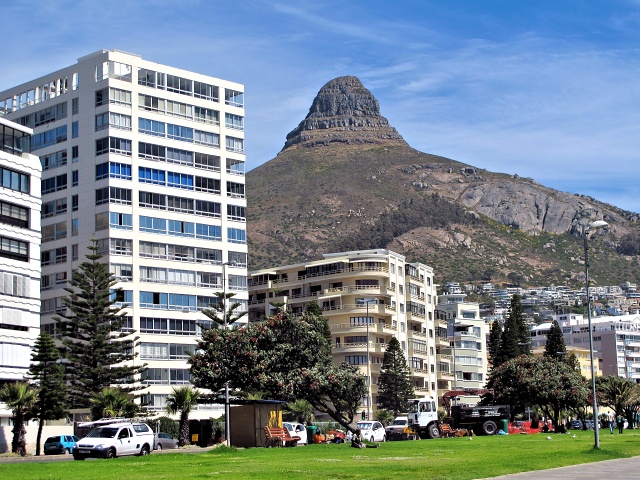
[Sea Point] Lion’s head cannot be missed

[Cape Town - Mouille Point] Mouille Point lighthouse adds a splash of color to the surroundings
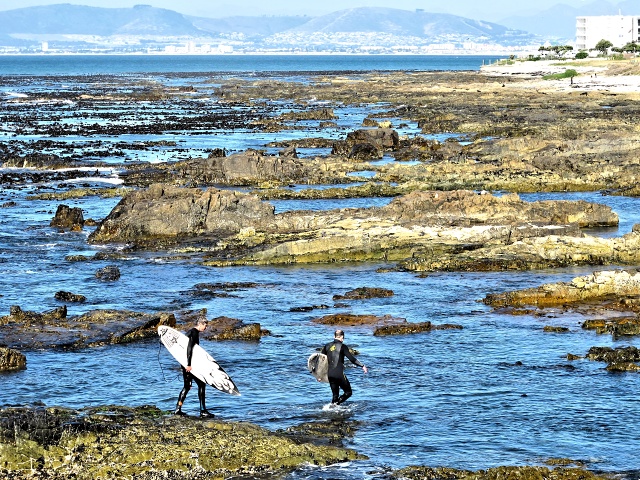
[Cape Town - Mouille Point] Surfers thrive even in this environment

[Cape Town] The National Stadium—an interesting, stylistically simple construction
Kirstenbosch Botanical Gardens
The program for the following day was determined, as I had to use the two-day bus ticket. I hopped on the Blue line and took a tour of the inland side of Table Mountain. I got off at Kirstenbosch Botanical Gardens and spent several very pleasant hours in these extremely large gardens. The expanse of land that was originally owned by the diamond magnate and person whose influence formed large African territories – Sir Cecil John Rhodes – is astonishing. During his lifetime, he was perceived as a very controversial figure, but thanks to his Will, opinion changed after his death. Today he is one of South Africa’s icons, almost exclusively positively assessed. I especially enjoyed the large part of the gardens dedicated to Fynbos. Although there are only four basic types of this shrub, the number of variations is enormous and seeing them at close range was just breathtaking.

[Kirstenbosch] Kirstenbosch botanical gardens—a very pleasant place
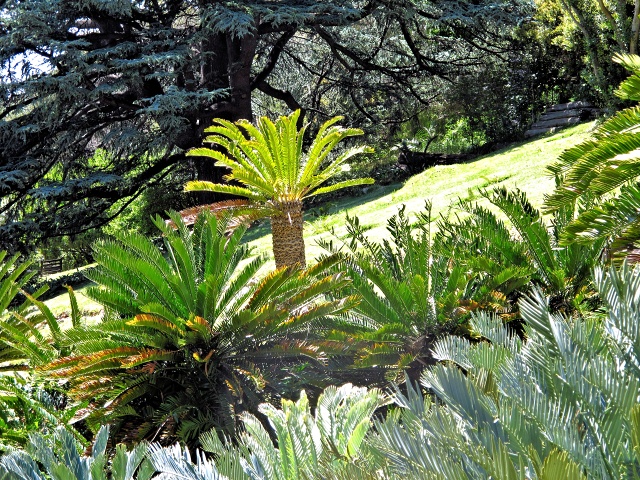
[Kirstenbosch] Kirstenbosch botanical gardens

[Kirstenbosch] Statue in Kirstenbosch botanical gardens
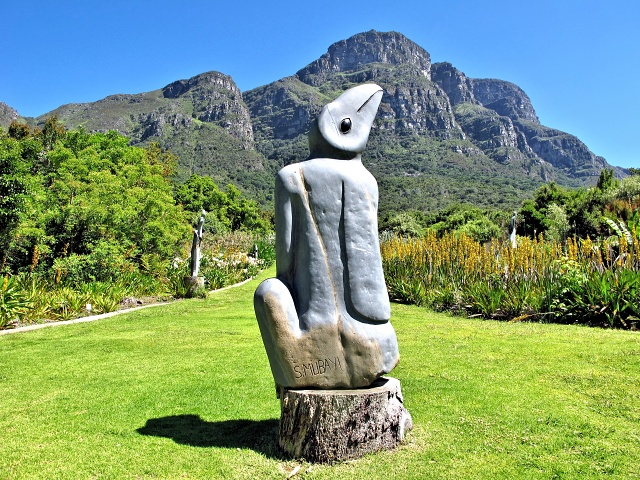
[Kirstenbosch] Statue in Kirstenbosch botanical gardens
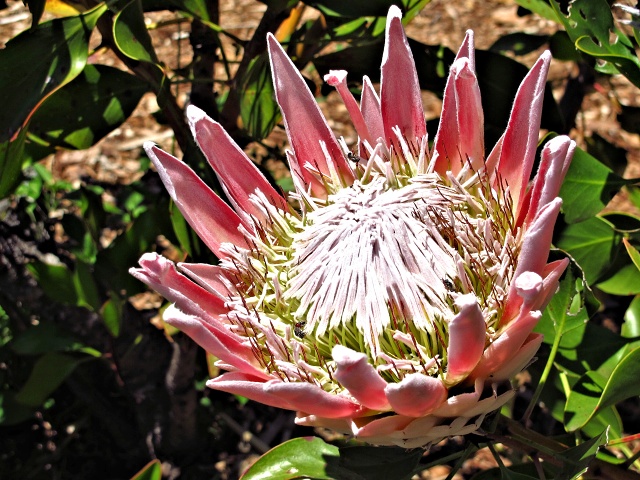
[Kirstenbosch] King Protea - South Africa’s national flower
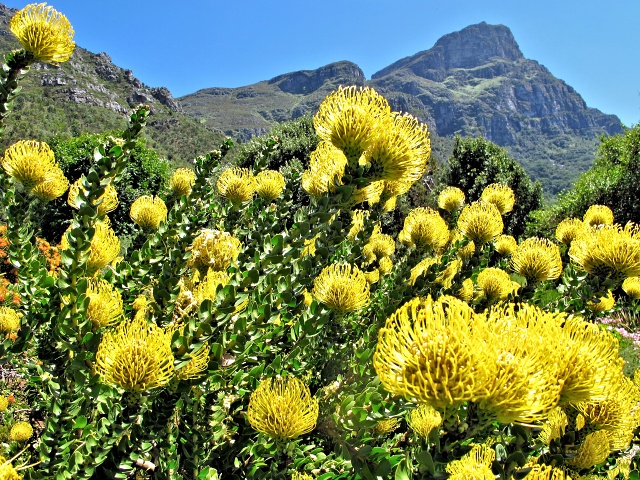
[Kirstenbosch] Yellow variety of Fynbos

[Kirstenbosch] Orange variety of Fynbos
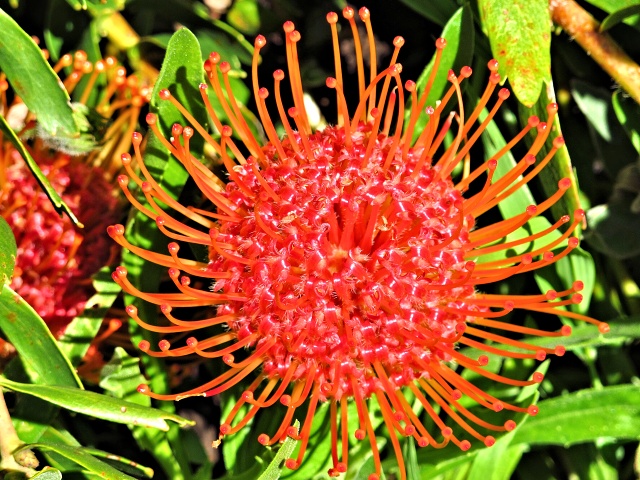
[Kirstenbosch] Close up of Fynbos
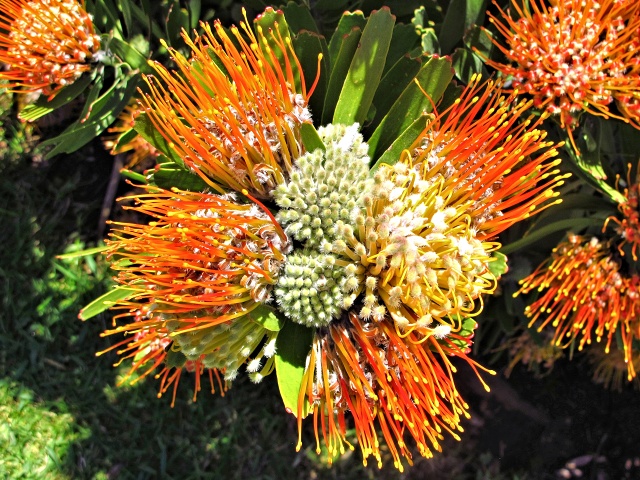
[Kirstenbosch] Fynbos
Hout Bay for the Second Time
The Blue line transported me to Hout Bay, where I had spent the night before arriving in Cape Town. Due to the bad weather, I had not seen much the first time, only on arrival. In the morning, everything had been totally covered in rain and fog. This time, the sun was shining as if on hire, but the wind was also blowing like crazy. That would have bothered me on the bike, but in the bus I just pulled down the hood of my softshell. At the harbor, there is the pub of a local fishing association, which also sells fresh fish. They have a nice slogan: “If it is any fresher, it is definitely still swimming in the sea.” I had grilled fish with a quarter-liter bottle of rosé wine, no fries, and it was fantastic sustenance. The rosé wine convinced me that I should go to Seal Island after all and so I boarded a boat and went to look at the seals in the bay. I sumptuously inhaled large amounts of unpleasant malodor while enjoying the unrelenting cheerfulness of the seals in the ocean waves.

[Hout Bay] House on the beach covered in sand
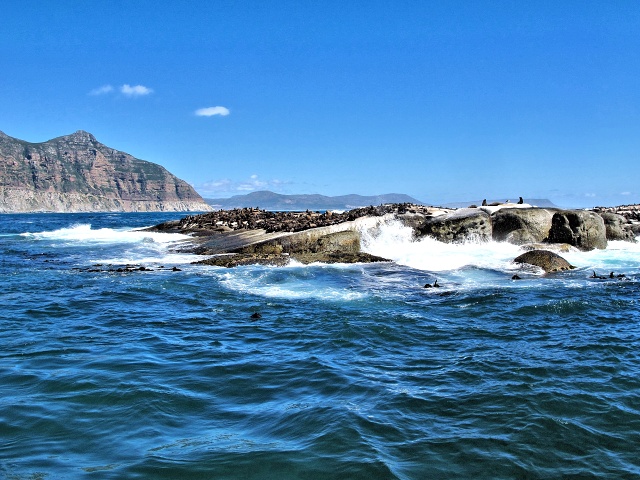
[Hout Bay] Seal Island with its colony of Cape Fur Seals; Chapman's Peak Drive in the left background

[Hout Bay] Seals laze around right in the harbor
Sunset on Signal Hill
The last bonus of the two-day ticket was the late afternoon trip up Signal Hill. The bus departed from the Waterfront at 18:00, took a scenic drive through Camps Bay, where I had already been several times, but still had not grown weary of. On the road familiar to me, we reached the saddle between Table Mountain and Lion’s Head and continued on to Signal Hill. The parking area at the peak was full, people were eating at the picnic tables and washing the food down with wine, which is normally an illegal act. It is prohibited to consume alcohol in public. I was also prepared. In Hout Bay I had bought a screw-top 0.7- liter bottle of Stellenbosch Pinotage and had wisely borrowed a glass from the hostel. The indication of the planned departure was interesting – five minutes after sunset. Beautiful views, although from the photographic point of view, the best scenes were on the return bus journey. The city was lit up like a Christmas tree, mingling with the remnants of daylight.

[Cape Town - Signal Hill] Tourist bus to Signal Hill

[Cape Town - Signal Hill] National Stadium from Signal Hill

[Cape Town - Signal Hill] The city center from Signal Hill

[Cape Town - Signal Hill] Sunset over Lion’s Head
Cold Turkey
Three months of daily cycling induces physical addiction. On the fourth day without my bike I could hardly stand it. I found a 16-km long cycle path to Table View, it was clear to me that I would go on a cycling trip the following day. I started just after 8 a.m. Of course, I was traveling light, with only a handlebar bag. In it, I carried only a spare tube and three bananas, and I wound a bike lock around the seat post. It was Sunday, the city was deserted, the route to the Civic Centre was comfortable and safe. The cycle path was not marked on the map, but I knew that the route led along the road reserved for the MyCity buses going to Table View. It is forbidden to cycle on it, so I tried a few surrounding streets, and in 10 minutes I was on the bike path. The first 6 km leads through an industrial zone, which in the beginning is also the zone of homeless people. Their boxes and blankets which they do not remove for the day are spread out there, nobody is going to steal anything from them. Then the cycle path turns towards the coast and around the Milnerton lagoon and the ocean shore leading to Table View, and a little farther. It is possible to cycle easily on normal roads to Bloubergstrand and along the seafront promenade. That is probably only for pedestrians in the northernmost part, it is narrow, but there was no sign prohibiting bikes. I cycled considerately and nobody took offence, even though there were many people promenading on Sunday.
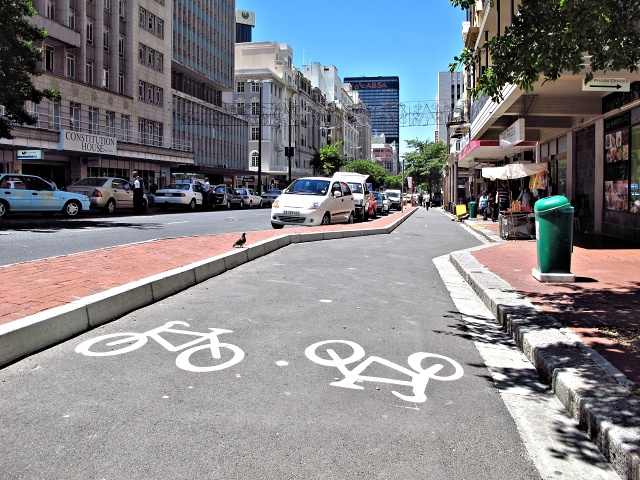
[Cape Town] Cycle path in the city center
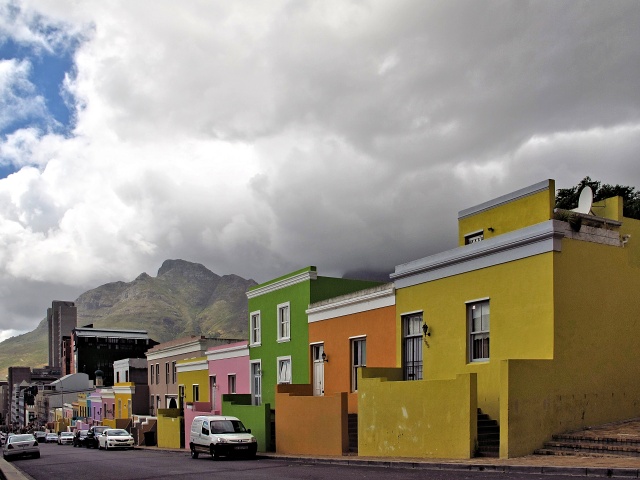
[Cape Town - Bo-Kaap] Attractively colored homes in the Muslim neighborhood of Bo-Kaap
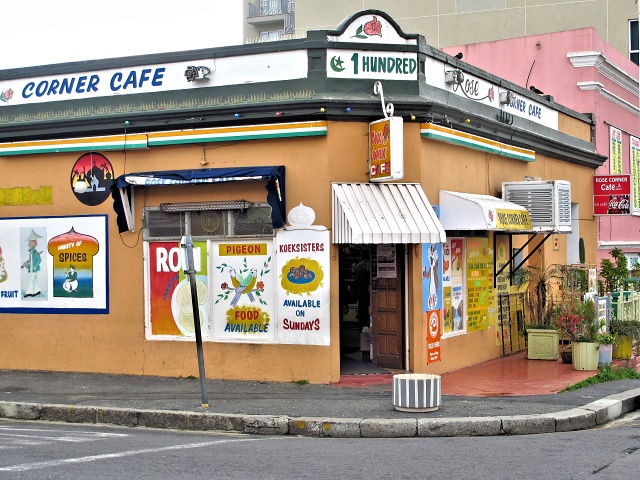
[Cape Town - Bo-Kaap] Café and corner store
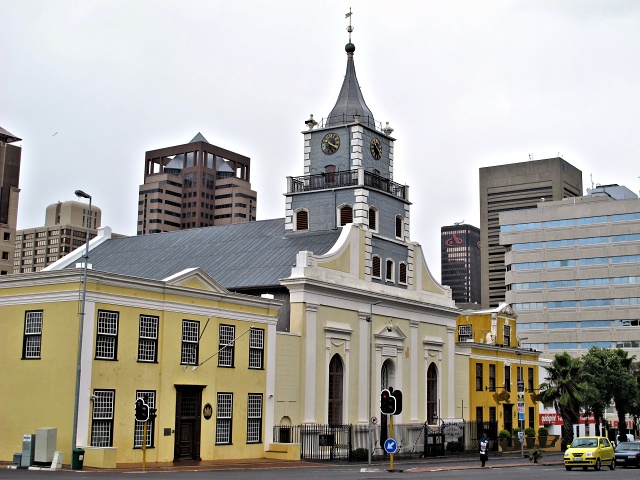
[Cape Town] The first Catholic Church in the city—at the time of the ban on the Catholic faith, the Church was converted into a warehouse

[Cape Town] The facade of the Museum of Gold
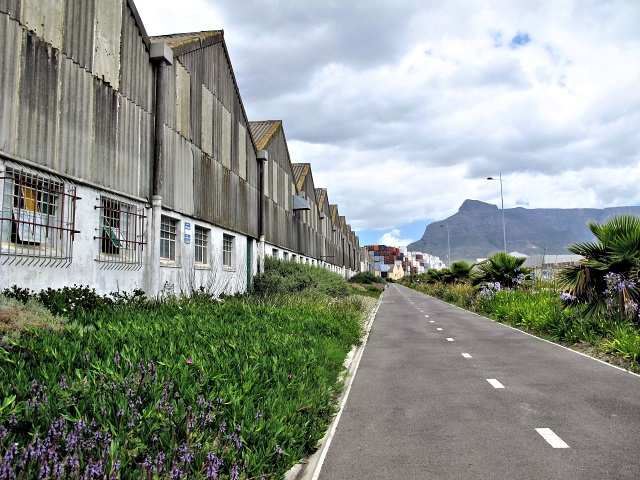
[Cape Town - Woodstock] When exiting the city, the cycle path leads through the industrial zone
I enjoyed it on the bike, an easy flat ride without a very strong wind. People were paddling in the surf, occasionally a child would get completely wet, but no one was swimming. Only the omnipresent surfers in wet suits were swimming on their boards, waiting for a favorable wave. Above it all, Table Mountain dominated the horizon as the most highly visible landmark of the entire region. Along the way, there were several attractions - flamingos in the Milnerton lagoon, motorized paragliders on Sunset Beach, a huge traditional flea market in Milnerton.

[Milnerton Lagoon] Lagoon with flamingos, cycle path on the left, golf course on the right
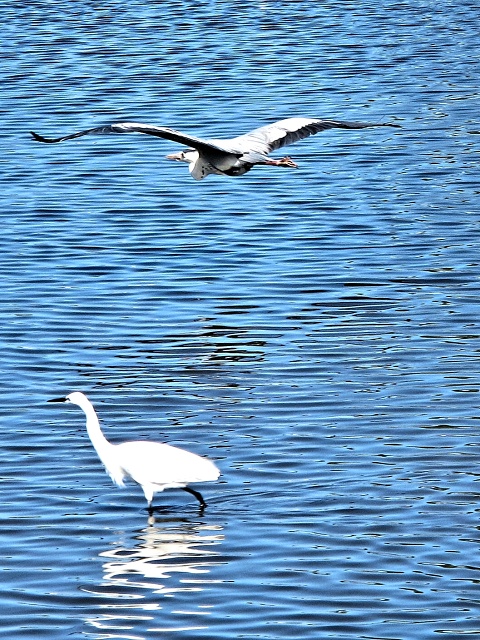
[Milnerton Lagoon] Flying flamingo

[Table View] Coastal dunes with Table View in the background

[Table View] Nomen omen – beaches around Table View provide beautiful vistas of Table Mountain
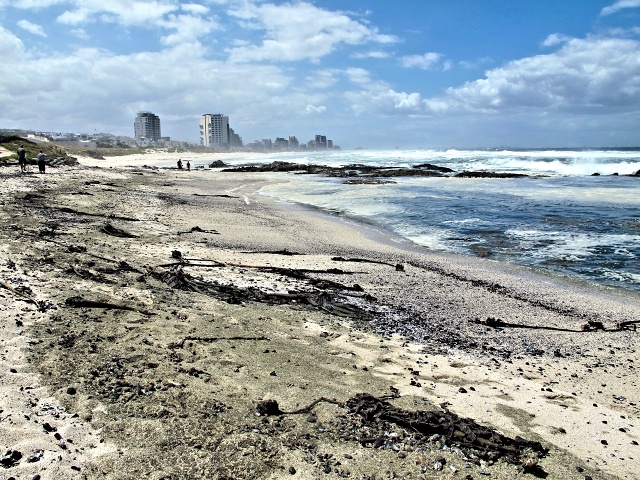
[Table View] Sunset Beach

[Table View] Shipwreck at Sunset Beach
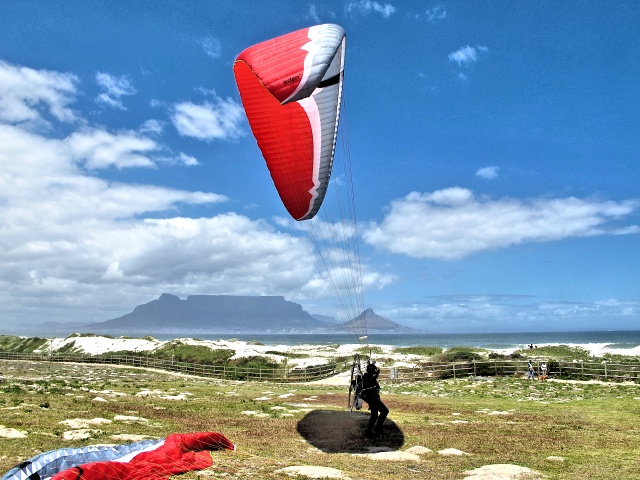
[Table View] A paraglider takes off
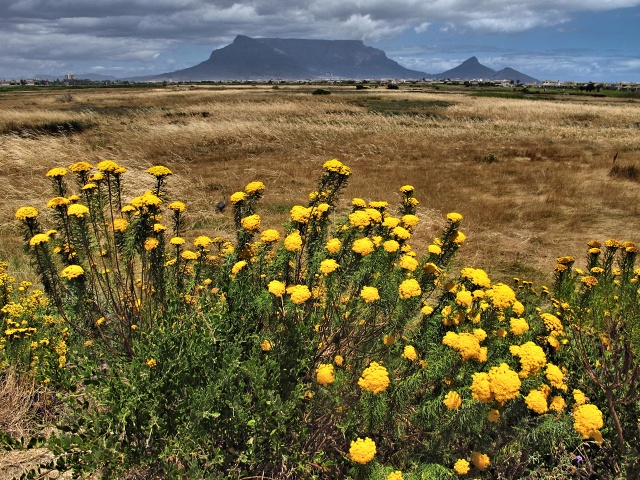
[Milnerton] Lagoon surroundings

[Woodbridge] Milnerton lighthouse
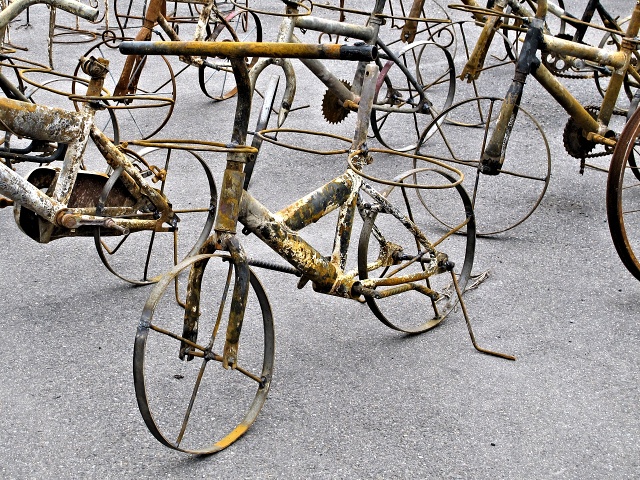
[Milnerton] The bikes at the flea market were of a similar color to mine
I could not get enough of cycling. I did a sightseeing tour of the center of Cape Town. I still had not had enough, so I cycled across the Waterfront to the beaches south of the city – Sea Point, Clifton, Camps Bay, Bakoven up to Llandudno, where I turned around. On my return to the city, I went through the saddle between Table Mountain and Lion’s Head and also pedaled up Signal Hill due to an excess of energy. The wind there was really strong, I would have probably suffered for the two hours up to sunset without a jacket. Besides, a descent in the dark would have been quite dangerous. Therefore, I scanned the city from above and returned to the hostel. I had cycled 98 km, thus concluding the year’s trip – a total of 6,329 km covered by bike.
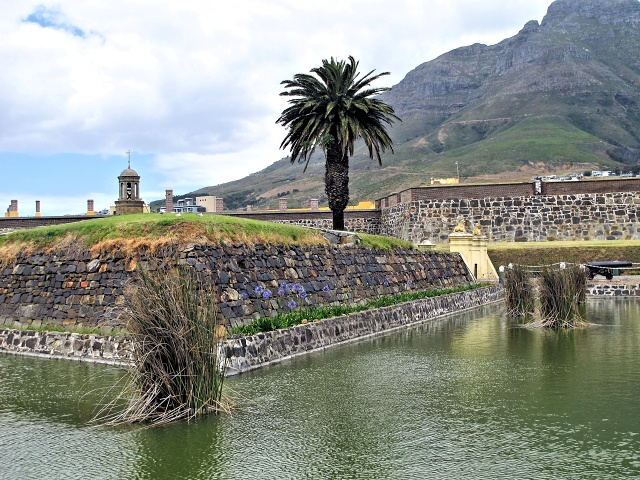
[Cape Town ] The Castle of Good Hope
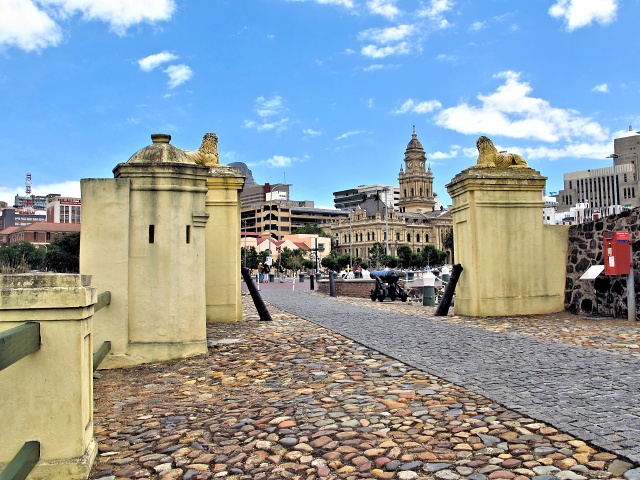
[Cape Town ] The Castle gate leads to the Grand Parade

[Sea Point] Public swimming pools – the Atlantic Ocean is definitely not suitable for swimming

[Clifton] Most desirable and most expensive location on the Atlantic coast

[Clifton Bay] The beach is framed by rocks
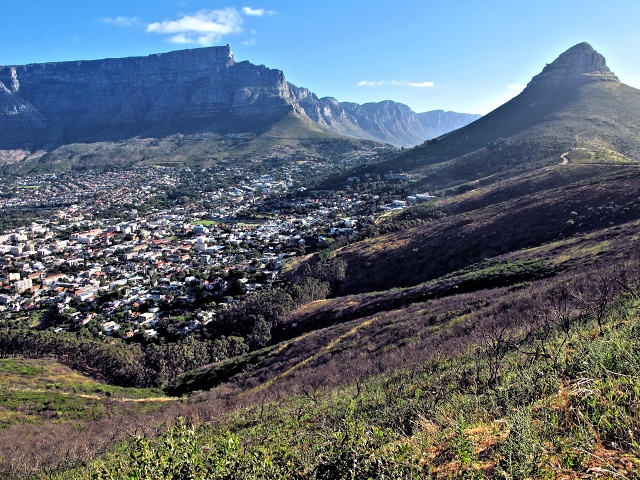
[Cape Town - Signal Hill] Table Mountain on the left, Twelve Apostles mountain range in the middle, Lion’s Head on the right

[Cape Town - Signal Hill] Waterfront shopping and entertainment center
Toys
As already mentioned, I had not found a proper toy store in Cape Town. I had to take something home to my four grandchildren and I did not want to spoil their taste with plastic molded products. About 20 km from Cape Town there is reportedly the largest shopping mall in Africa (at least it was, at the time of its completion three years ago) – Canal Walk in Sun City. I found a MyCity bus which passes this mall at a distance of less than 3 km on the route to Table View, and decided to go there. I had to buy a special card similar to a credit card for about 25 Rands to catch the bus. You get a PIN and then you can recharge it at MyCity ticket offices, but you must know the PIN. I put the exact amount for the return trip on it. Buses run very frequently, are clean, comfortable and almost empty in off-peak time. I downloaded a map to the Kindle, because the path from Woodbridge station was not straightforward. There is only one route to the shopping mall and when this is missed, it means another two kilometers. It paid off, there were two gigantic toy stores and, despite the prevailing flood of junk, I got what I had come for. And I even managed to meet the restrictive condition that Adam and Lukáš must have completely identical gifts, including the color.
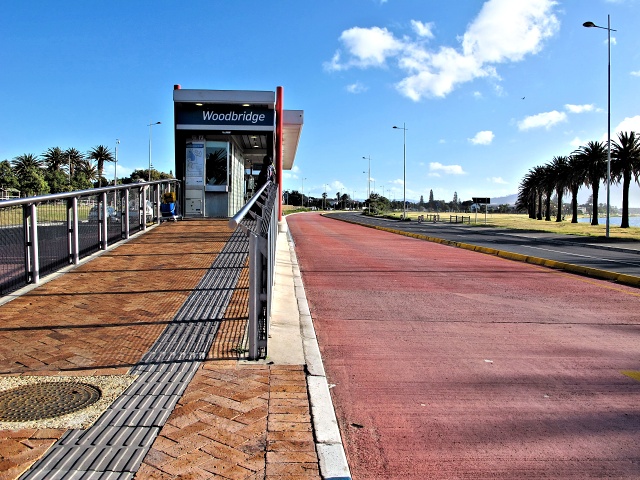
[Woodbridge] Woodbridge bus station for the line which mostly operates in the reserved red lane
Nothing Beats Polite Bargaining
I returned from shopping as a true tourist, backpack on my back and a bulging plastic bag in my hand. It was past 7 p.m., but still daylight. I suspected that there would be problems. Right at the Civic Centre, which is the final stop on the route to Table View, several people tried it on me, but total ignorance worked. Then an importunate fellow hit on me and started typically, "I am not a criminal, I don't want money, but I'm hungry." So was I, I told him and politely asked him to let me be. Of course, it did not work. "Look what I have here," he said and opened a folder in which he had a knife. No problem, I thought, as long as he is not holding it in his hand, it is OK. So I got tough and told him, "Stick the knife up your ass!" This shook him visibly and for a moment he retreated, but returned after a few meters and showed me that he had a second knife too. So I jovially said, "So stick both knives there!" His self-confidence was gone, but he still claimed that I had to give him something. "Don’t fuck with me!" I said to him, "And I mean it!" This finished him and he stopped bothering me.
What is remarkable about this story is that, while walking, we successively passed by three guardians of public order to whom it had to be clear that the man was troubling me considerably, yet they did not interfere in any way. Probably because they saw I was coping with the situation. These uniformed guards are something like the City Police in the Czech Republic, but there they exclusively focus on the protection of tourists. Perhaps they would have intervened only after he really stuck the knife into me.
Local authorities recommend not to give beggars anything. Firstly, it solves nothing and often it is dangerous for the donors. There have been frequent cases when a tourist has pulled out his wallet, just to be deprived of it immediately. Authorities especially warn against giving money to children. They often buy drugs with the money procured through begging, or hand over the money to the adults protecting them. Therefore, the authorities recommend giving money only to established charitable organizations.

[Cape Town] Authorities are trying to increase security, especially that of tourists
Racism
The end of Apartheid officially put an end to the racism of whites against blacks. However, racism of blacks against whites still functions and every white person, even tanned brown as I was, is convinced of this on a daily basis. No human qualities, clothing, appearance are important, only skin color. A white guy walks around, the black hides a cigarette and reaches out his hand saying he has nothing to eat and maybe he receives something, this is how it works there. The most annoying for me personally were the young girls with small children. The girl would be smoking like a chimney, but would capture me in the street, saying that she was hungry and that I had to give her something. I would tell her, "Quit smoking and you’ll have enough money for food." Well, she would get mad at hearing this. Some girls were not smoking, but it was the same story. I would tell her, "Go to that guy who made the baby, it was not I," and again I would get an hysterical reaction.
Museums and Farewell to the Mother City
There is a very nice large park in the city center, called the Company Gardens, containing several museums. The Jewish Museum is devoted to local Jewish settlements, comprised mostly of Eastern Jews from the Baltic states of the former Russia. The community was strong. In the 20th century one of its members was a very successful mayor. The exposition was impressive, graphically very well designed, with replicas of original wooden houses from District Six and a number of original objects. The neighboring building is a Holocaust Museum which is also worth a visit.
Just a few meters away is the National Gallery and this is, in my opinion, a fiasco. The curator bet on contrast, modern daub hanging next to a Dutch Master. I did not like it. The graphics and paintings by black Africans were more interesting, among which I really liked a couple of items. Part was devoted to the exhibition of some Lyon Biennale and that was really bad. Poor photographs lacking any composition were presented as great Art. I really did not understand what they were doing there. The highlight was several installations of the "dug-up junkyard" type. You take a pile of junk, scatter it on the floor and give it a noble name. And I, idiot, thought that Art was derived from the word "Skill". After the National Gallery, I lost my appetite for any more museums.

[Cape Town] Company's Gardens

[Cape Town] View from the Company’s Gardens of Table Mountain, almost impossible to believe that this is in the city center

[Cape Town] Chinese lantern in the Company’s Gardens

[Cape Town] Flower in the Company's Gardens

[Cape Town] Squirrel in the Company’s Gardens

[Cape Town] The National Gallery, with Jewish synagogue in the background

[Cape Town] Altar in the Jewish synagogue

[Cape Town] Tuynhuys – office of the Presidency
In the afternoon and evening, I boozed a little on Long Street and thus celebrated the thoroughly successful trip.
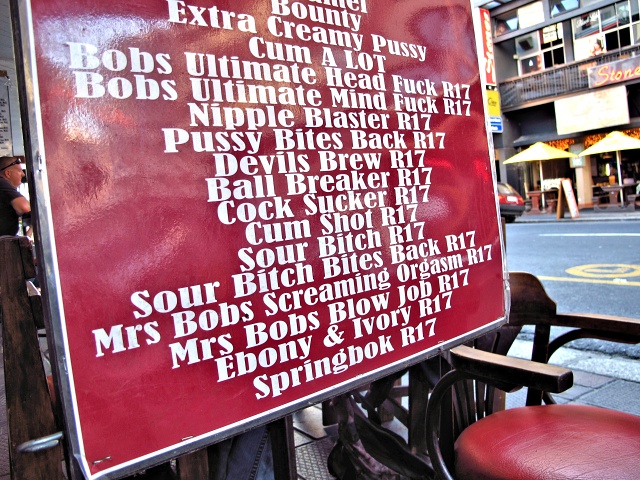
[Cape Town] I am ashamed to repeat the names on Bob's Pub cocktail menu
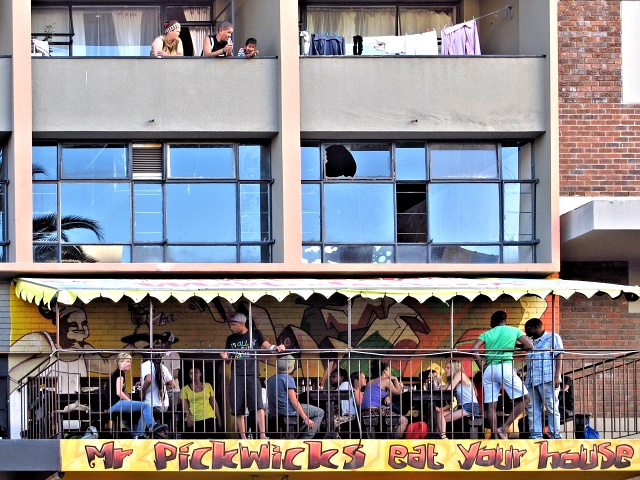
[Cape Town] Living in Long Street is not easy, the pubs are full of boozing people long into the night
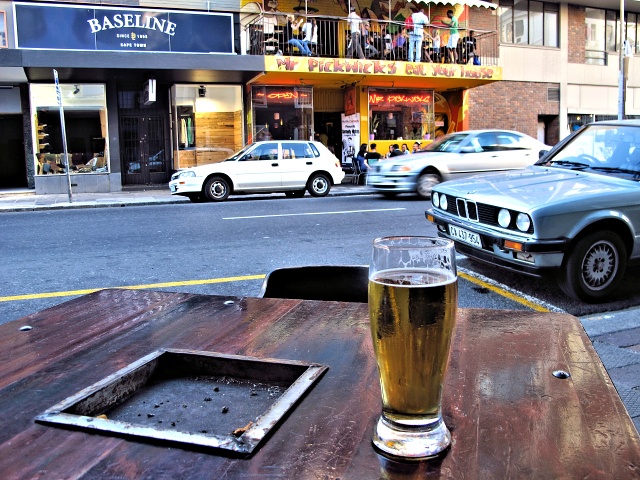
[Cape Town] Long Street is best enjoyed in a pub
Like Clockwork
Packing was easy. I wrapped the boxes in shrink foil, which is the best prevention against the loss of items through tearing. In the hostel, I had ordered transport to the Airport at 2 p.m., stressing that I would have a big box containing the bike. Exactly at 14:00 the driver stopped at my hostel. He had an old Mercedes (the type called “piano”) and claimed that the box would fit on the back seat. We wrestled with the box for a while, but without any success. I was calm, I had a margin of at least two hours. The driver was also calm, he had a Plan B, to put the box on the roof. He did not have a roof rack, only two strong ropes with which he tied the box. It looked solid, so I did not protest. Only the very strong wind caused me a little concern, but unnecessarily. In half an hour we were at the Airport.
There it all went like a well-oiled machine. At first, I managed the VAT refund for purchased gifts (value of the exported goods must exceed 250 Rands, VAT is 14%). It was three and a half hours before departure and Lufthansa had already opened their check-in. Surprisingly, I paid only 100 Euros for the bike (when I had bought the plane ticket, I was told it would be 150 Euros). Then I was assigned a guide and helper, we took the boxes on a trolley two floors down to the oversized luggage department. I waited for the scanner check and that was it. At 19:00 we took off. In eleven hours I was in Munich and after 10 a.m. I was back home. Now there would only be the usual two weeks of adaptation to the local conditions of a sedentary life and the dreary, cold weather. This was to be the last of my trips for 2012. Hopefully, I will also manage something next year...

| 

















































































